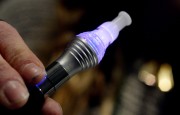There are almost as many different methods for consuming cannabis concentrates (also known as extracts) as there are different types available.
Dabbing, vaping, wax, shatter, oil, rigs. It can be quite overwhelming to someone who just wants to give something new a try, especially when it often required $100-plus in equipment purchases. Additionally, not all ways of consuming extracts are created equal, they all have their pros and cons for different types of users.
But don’t let that stop you — just do some research. Read up on our Concentrates 101 series, check The Cannabist’s vaporizer reviews, talk with your 420-friendly pals about their experiences and think about what would suit you personally. Here are ways concentrates are commonly put to use:
The vaping phenomenon
Sensational swag: Vaporizers, vibrators and more among items included in 2015 Oscar gift bags
Opinion: How vaporizers will fuel Big Tobacco’s marijuana expansion
Word: ‘Vape’ (the verb and noun) is Oxford Dictionaries’ Word of the Year 2014
Watch The Cannabist Show. Follow The Cannabist on Twitter and Facebook
With Cannabis
Probably the most accessible way for new users to consume cannabis extracts is by crumbling them up on top of a pipe bowl or into a joint. This allows people to essentially “dip their toe” into the concentrate pool and see if they even like the additional potency offered by these products. The downsides to this method are that it doesn’t allow the user to experience the concentrate itself directly and that much of it ends up wasted as part of the smoking process. Only recommended for those who have no other choice and no other equipment to smoke or vaporize, this is basically the most Luddite, caveman style of smoking concentrates.
Hash Pipe
There are specialized pipes intended for the consumption of hash (primarily water hash or kief, but certain pipes can work with oil and solvent extracts as well). These pipes generally require nothing more than a good lighter and occasional replacement screens, and allow the user to experience the hash on its own without the flavor and smoke of flowers. The relatively small entry price makes this option appealing to those who have more than a passing interest in extracts and want to really see what the new world of cannabis is all about.
The complete series
Part 1: What’s on the market? Info about kief, BHO, water hash and others
Part 2: How should I smoke this shatter? Ways to consume concentrates
Part 3: Are concentrates right for me? On potency, expected effects and more
Vaporizer
There are two main types of vaporizer: portable and desktop. Though the large, expensive Volcano-style vaporizers still exist on the market, they don’t tend to work particularly well with extracts.
For the most part, these at-home units have been replaced by portable, convenient “vape pen” options which range in price from $30 to $200 depending upon features and quality. Rather than being tethered to a power outlet for the entire smoking session, these devices can be charged via USB and taken anywhere, allowing the user complete mobility. Most personal vaporizers of this ilk can accept only solvent-extracted extracts (wax, shatter, oils), but some can also vaporize high-quality water hash and even flowers if they are designed to handle various substances.
Vaporizers allow the user to experience the pure flavor of the extract while avoiding any actual combustion of the material, which generally makes it an easier experience on the lungs and results in less carcinogens and tar than smoking.

The downside to portable vaporizers is that many of the units on the market have weak batteries or heating elements and tend to give mediocre hits, which don’t completely vaporize the concentrate and result in degraded flavor and lesser effects compared to a more thorough way of consuming such as smoking in a hash pipe or dabbing (see below). The other downside to many portable vaporizers is that they have been linked to nefarious chemicals such as arsenic and boron, which are often left as residuals during their manufacturing process (most of these units are made in China, where regulations are looser). It is suggested that you study your options before purchasing any vape pen, as there are high-quality units on the market that are free of these issues.
Dabbing
A still somewhat-controversial yet arguably most effective way of consuming concentrates is dabbing. The process involves vaporizing extracts on a hot surface (the “nail,” generally made of titanium, quartz or ceramic) and then inhaling them though an “oil rig,” which is a specialized pipe meant for this use.

For all the older hippies in the audience, this is basically the same thing as a “knife hit,” but fancier and way less harsh on your throat.
Through the aid of a butane torch (or an electronic heating element in the case of “e-nails” — the newest and most expensive pieces of equipment for concentrate consumers), the user heats up the nail, places their concentrate of choice on a “dabber” (again, usually titanium, quartz, or ceramic) that allows them to safely dab the concentrate onto the hot surface. Ideally, the temperature of the surface should lie between 550 and 750 degrees Fahrenheit, with the higher end of the spectrum causing a more thorough vaporization and the lower end of the spectrum preserving more flavor and terpene content.
The cost of a proper dab rig can vary from as little as $50 to as much as $50,000 for some of the ultra-artistic, rare pieces made by the most revered glassblowers in the world.
Do you have other questions about the methods for consuming concentrates? Let us know in the comments below.
